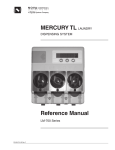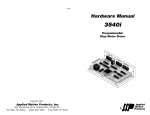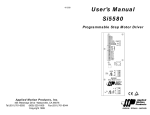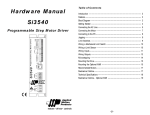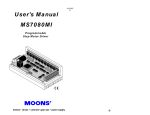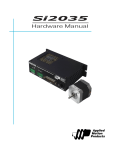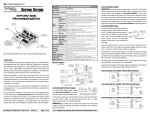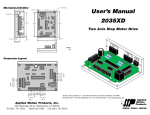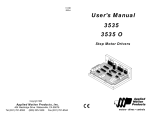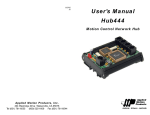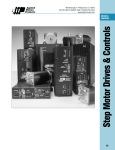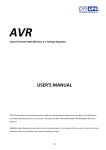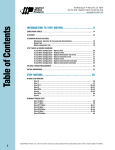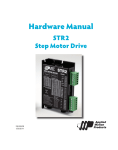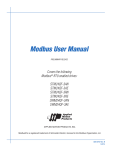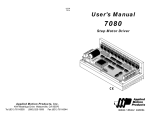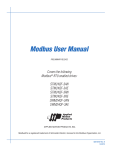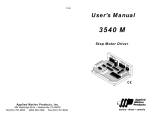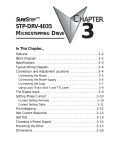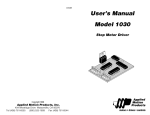Download Hardware Manual 1240i Programmable Step Motor Driver
Transcript
Hardware Manual 1240i Programmable Step Motor Driver motors • drives • controls -2- Table of Contents Introduction Features • Precise pulse width modulation switching amplifiers providing up to 1.2 amps per phase and microstepping to 50,800 steps per revolution. • Accepts 12 - 42 VDC power supply. • Powerful, flexible, easy to use indexer. • Connects by a simple cable to your PC for programming (cable included). • Microsoft WindowsTM-based software for easy setup and programming • Eight inputs for interacting with the user and other equipment. • Three outputs for coordinating external equipment. • External trigger I/O is optically isolated, 5-24V, sinking or sourcing signals. PC/ MMI port is RS-232. • 3.0 x 4.0 x 0.65 inch overall dimensions. • Optional man machine interface (MMI) allows operator to enter distances, speeds, cycle counts and more. • CE Compliant Block Diagram 12 - 42 VDC CW LIMIT CCW LIMIT to PC/MMI -3- eeprom Optical Isoation Si™ Optical Isolation MOSFET 3 State PWM Power Amplifier Microstepping Indexer Sequencer RS232 Optical Isolation -4- motor phase B INPUT1 INPUT2 INPUT3 INPUT4 CW JOG/IN5 CCW JOG/IN6 Internal Power Supply motor phase A Introduction --------------------------------------------------------------------- 4 Features -------------------------------------------------------------------------- 4 Block Diagram ------------------------------------------------------------------- 4 Getting Started ------------------------------------------------------------------ 5 Connecting the Power Supply --------------------------------------------------- 6 Choosing a Power Supply ------------------------------------------------------- 7 Connecting the Motor ----------------------------------------------------------- 8 Connecting to the PC ------------------------------------------------------------ 9 Jogging ------------------------------------------------------------------------- 10 Limit Switches ----------------------------------------------------------------- 10 Wiring a Mechanical Limit Switch --------------------------------------------- 11 Wiring a Limit Sensor ---------------------------------------------------------- 11 Wiring Inputs ------------------------------------------------------------------- 12 Wiring Outputs ----------------------------------------------------------------- 14 Microstepping ------------------------------------------------------------------ 15 Mounting the Drive ------------------------------------------------------------- 16 Mounting the Optional MMI --------------------------------------------------- 17 Recommended Motors ---------------------------------------------------------- 19 Mechanical Outline ------------------------------------------------------------- 20 Technical Specifications -------------------------------------------------------- 21 Mechanical Outline - Optional MMI ------------------------------------------- 22 Thank you for selecting an Applied Motion Products motor control. We hope our dedication to performance, quality and economy will make your motion control project successful. If there’s anything we can do to improve our products or help you use them better, please call or fax. We’d like to hear from you. Our phone number is (800) 525-1609 or you can reach us by fax at (831) 761-6544. OUT1 OUT2 OUT3 Getting Started Connecting the Power Supply To use your 1240i motor control, you will need the following : 4 a power supply (see page7 for help choosing one). 4 a compatible step motor (see page 19 for recommended motors). 4 a small flat blade screwdriver for tightening the connectors - an Applied Motion Products screwdriver suitable for this purpose is included with your drive. 4 a personal computer running Windows 3.1, 95, 98 or NT with a 9 pin serial port (486 or better with 8 MB ram recommended) 4 the Si ProgrammerTM software that came with your 1240i 4 the programming cable that came with your 1240i 4 Si ProgrammerTM software manual - on the CD that came with your 1240i If you need information about choosing a power supply, please read Choosing a Power Supply on the next page. The sketch below shows where to find the important connection and adjustment points. Please examine it now. pc/mmi connector Connect the motor power supply as shown below. Use no smaller than 18 gauge wire. Be careful not to reverse the wires. Reverse connection may destroy your driver, void your warranty and generally wreck your day. DC Power Supply 12 - 42 V -V+ All Mating connectors included. If your power supply does not have a fuse on the output or some kind of short circuit current limiting feature, you need to put a 1 amp fast acting fuse between the drive and the power supply. Install the fuse on the + power supply lead. + 1A fuse mounting hole (1 of 4) i/o connector inputs 1,2,3,4 jog cw jog ccw cw limit ccw limit out 1,2,3 power LED power/motor connector DC power supply motor * Always use the blue & white Applied Motion screwdriver with these connectors. Larger screwdrivers may remove the plastic dimples that prevent the screws from falling out. -5- -6- 1240i Choosing a Power Supply Please follow the recommendations below for choosing a power supply: Voltage Chopper drives like the 1240i work by switching the voltage to the motor terminals on and off while monitoring current to achieve a precise level of phase current. To do this efficiently and silently, you’ll want to have a power supply with a voltage rating at least five times that of the motor. Depending on how fast you want to run the motor, you may need even more voltage than that. If you choose an unregulated power supply, do not exceed 28 volts. This is because unregulated supplies are rated at full load current. At lesser loads, like when the motor’s not moving, the actual voltage can be up to 1.4 times the rated voltage. For smooth, quiet operation, a lower voltage is better. Current The maximum supply current you could ever need is the sum of the two phase currents. However, you will generally need a lot less than that, depending on the motor type, voltage, speed, and load conditions. That’s because the 1240i uses switching amplifiers, converting a high voltage and low current into lower voltage and higher current. The more the power supply voltage exceeds the motor voltage, the less current you’ll need from the power supply. A motor running from a 24 volt supply can be expected to draw only half the supply current that it would with a 12 volt supply. We recommend the following selection procedure: 1) If you plan to use only a few drives, get a power supply with at least twice the rated phase current of the motor. 2) If you are designing for mass production and must minimize cost, get one power supply with more than twice the rated current of the motor. Install the motor in the application and monitor the current coming out of the power supply and into the drive at various motor loads. This will tell you how much current you really need so you can design in a lower cost power supply. If you plan to use a regulated power supply you may encounter a problem with current fold back. When you first power up your drive, the full current of both motor phases will be drawn for a few milliseconds while the stator field is being established. After that the amplifiers start chopping and much less current is drawn from the power supply. If your power supply thinks this initial surge is a short circuit it may “fold back” to a lower voltage. Because of that, unregulated power supplies are better. They are also less expensive. -7- Connecting the Motor Never connect or disconnect the motor to the driver when the power is on. Insulate unused motor leads separately, and then secure. Never connect motor leads to ground or to a power supply. You must now decide how to connect your motor to the drive. A+ Four lead motors can only be connected one way. Please follow the sketch at the right. Red 4 lead motor A– Blue Yellow B+ White B– 4 Leads Six lead motors can be connected in series or center tap. In series mode, motors produce more torque at low speeds, but cannot run as fast as in the center tap configuration. In series operation, the motor should be operated at 30% less than the rated current to prevent overheating. Wiring diagrams for both connection methods are shown below. Note: NC means not connected to anything. A– NC A+ Grn/Wht A– Grn/Wht 6 lead motor White Green A+ NC Red Black B– NC Red/ Wht 6 lead motor White Green Red B+ B– 6 Leads Series Connected Red/ Wht Black B+ 6 Leads Center Tap Connected -8- NC Eight lead motors can also be connected in two ways: series and parallel. As with six lead motors, series operation gives you more torque at low speeds and less torque at high speeds. In series operation, the motor should be operated at 30% less than the rated current to prevent overheating. The wiring diagrams for eight lead motors are shown below. A+ Orange Blk/Wht Org/ Wht A– Black Red B+ Red/ Wht Orange Blk/Wht 8 lead motor Org/Wht A– A+ Yellow Yel/ Wht B– Yel/ B+ Wht 8 Leads Series Connected Two of the 1240i input terminals are provided for jogging the motor. The inputs are labeled “JOG CW” and “JOG CCW”. Activating one of the inputs commands the drive to move the motor at a pre-designated speed until the contact is opened. A relay or mechanical switch can be used to activate the jog inputs. 5-24 volt circuitry can be used. The schematic diagram of the input circuit is shown below. If you’re using a switch or relay, wire one end to the JOG input and the other to the power supply negative (-) terminal. Then connect the COM input to the power supply positive (+) terminal. 8 lead motor Black Red Jogging Yel low Red/Wht B– 8 Leads Parallel Connected inside 1240i COM + 5-24 VDC SUPPLY - 2200 JOG CW 2200 JOG CCW Connecting to the PC •Locate your computer within 6 feet of the 1240i. •Your 1240i was shipped with a black adapter plug. It has a telephone style jack at one end and a larger 9 pin connector at the other. Plug the large end into the COM1 serial port of your PC. Secure the adapter with the screws on the sides. If the COM1 port on your PC is already used by something else, you may use the COM2 port for the 1240i. On some PCs, COM2 will have a 25 pin connector that does not fit the black adapter plug. If this is the case, and you must use COM2, you may have to purchase a 25 to 9 pin serial adapter at your local computer store. Limit Switches The 1240i has two limit switch inputs, LIMIT CW and LIMIT CCW. By connecting switches or sensors that are triggered by the motion of the motor or load, you can force the 1240i to operate within certain limits. This is useful if a program error could cause damage to your system by traveling too far. The limit inputs are optically isolated. This allows you to choose a voltage for your limit circuits of 5 to 24 volts DC. This also allows you to have long wires on limit sensors that may be far from the 1240i with less risk of intoducing noise to the 1240i. The schematic diagram of the limit switch input circuit is shown below. •Your 1240i was also shipped with a 7 foot telephone line cord. Plug one end into the adapter we just attached to your PC, and the other end into the PC/MMI jack on your 1240i. Never connect the 1240i to a telephone circuit. It uses the same connectors and cords as telephones and modems, but the voltages are not compatible. Programming Note: Always apply power to the 1240i after the SiTM Programmer software is running on your PC. -9- inside 1240i +5V +5V 10K 1240i Controller Chip 3 CW LIMIT+ CW LIMIT– CCW LIMIT+ CCW LIMIT– 4 1 2 2200 -10- Wiring a Mechanical Limit Switch Wiring Inputs You can use normally open or normally closed limit switches. Either way, wire them as shown here. The 1240i input circuits can be used with sourcing or sinking signals, 5 to 24 volts. This allows connection to TTL circuits, PLCs, relays and mechanical switches. Because the input circuits are isolated, they require a source of power. If you are connecting to a TTL circuit or to a PLC, you should be able to get power from the PLC or TTL power supply. If you are using relays or mechanical switches, you will need a 5-24 V power supply. This also applies if you are connecting the 1240i inputs to another Si product from Applied Motion, like the Si-1 and Si-100 indexers or the 3540i, Si3540, Si5580, 7080i and Si4500 indexer-drives. CW LIMIT+ CCW LIMIT+ + 5-24 VDC SUPPLY - 1240i CW LIMITCCW LIMIT- Wiring a Limit Sensor Some systems use active limit sensors that produce a voltage output rather than a switch or relay closure. These devices must be wired differently than switches. If your sensor has an open collector output or a sinking output, wire it like this: CW LIMIT+ + DC Power Supply – 1240i + Limit Sensor – output CW LIMIT- Wiring for Sinking or Open Collector Output If the sensor output goes low at the limit, select the option “closed”. If the output is open, or high voltage, choose “open”. + Proximity Sensor – output LIMIT+ 1240i inside 1240i COM 2200 IN1 2200 IN2 2200 IN3 2200 IN4 2200 JOG CW 2200 JOG CCW Note: If current is flowing into or out of an 1240i input, the logic state of that input is low. If no current is flowing, or the input is not connected, the logic state is high. The diagrams on the following pages show how to connect 1240i inputs to various devices. The maximum voltage that can be applied to an input terminal is 24 volts DC. Never apply AC voltage to an input terminal. Other sensors have sourcing outputs. That means that current can flow out of the sensor output, but not into it. In that case, wire the sensor this way: + DC Power Supply – COM 5-24 VDC Power Supply + COM 1240i switch or relay (closed=logic low) IN - LIMITWiring for Sourcing Output If the sensor output goes high at the limit, choose the program option “closed”. if the output is low at the limit, select “open”. -11- Connecting an Input to a Switch or Relay Use normally open momentary switch to trigger 1240i using Wait Input instruction. Use single throw switch for parameter selection using If Input instruction. Use normally open momentary switch for jogging. -12- Wiring Outputs IN/JOG COM MOTION+ IN 1240i SI-1 indexer + MOTION– - 5-24 VDC Power Supply + COM OUT+ IN 1240i 3540i, Si3540, 7080i, Si5580, Si4500 or Si-100 Connecting an Input to the Si-1 Motion Output (Set Si-1 motion signal to “in position”. Si-1 will trigger 1240i at end of each move). OUT– - 5-24 VDC Power Supply Before we discuss the output conditions, we need to talk about the circuitry. All three 1240i outputs are optically isolated. That means that there is no electrical connection between the indexer-drive and the output terminals. The signal is transmitted to the output as light. What you “see” is a transistor (NPN type) that closes, or conducts current, when the output is “low”. When the output is high, the transistor is open. Note: At power-up, the 1240i sets all three programmable outputs high (open circuit). The maximum voltage between any pair of + and - output terminals is 24 volts DC. Never connect AC voltages to the ! 1240i output terminals. Maximum current is 100 mA per output. +5V inside 1240i 330 OUT1+ Connecting a 3540i, Si3540, Si5580, 7080i or Si4500 (When output closes, 1240i input goes low). 5-24 + VDC Power Supply - COM + NPN Proximity Sensor – output IN 1240i Connecting an NPN Type Proximity Sensor to a 1240i input (When prox sensor activates, 1240i input goes low). 5-24 + VDC Power Supply - + PNP Proximity Sensor – output OUT1– 1240i Controller Chip Schematic Diagram of 1240i Output Circuit Since there is no electrical connection to the 1240i, you must provide the source of current and voltage, typically from a power supply. You must also limit the current to less than 100 mA so that the output transistor is not damaged. You would normally use a resistor for this, but some loads (such as PLC inputs) limit the current automatically. The diagram below shows how to connect an 1240i output to an optically isolated PLC input. 5-24 VDC Power Supply IN 1240i + COM – OUTPUT+ COMMON OUTPUT- INPUT 1240i Connecting a PNP Type Proximity Sensor to a 1240i input (When prox sensor activates, 1240i input goes low). -13- -14- PLC Microstepping Most step motor drives offer a choice between full step and half step resolutions. In full step mode, both motor phases are used all the time. Half stepping divides each step into two smaller steps by alternating between both phases on and one phase on. Microstepping drives like the 1240i precisely control the amount of current in each phase at each step position as a means of electronically subdividing the steps even further. The 1240i offers a choice of 13 step resolutions. The highest setting divides each full step into 254 microsteps, providing 50,800 steps per revolution when using a 1.8° motor. Mounting the Drive. The 1240i has four 0.156 inch diameter holes in the circuit board for mounting. Always use standoffs or spacers to support the 1240i: a 1240i with power connected will be damaged if you set it on a conductive surface without supports. The standoffs or spacers can be up to 0.25 inch in outer diameter. You can use #4 or #6 screws to fasten the 1240i. 0.156 inch Diameter mounting holes In addition to providing precise positioning and smooth motion, microstep drives can be used for motion conversion between different units. The 25,400 step/rev setting is provided as a means of converting motion from metric to english (there are 25.4 mm in an inch). Other settings provide step angles that are decimal degrees (36,000 steps/rev makes the motor take 0.01° steps). Some settings are used with lead screws. When the drive is set to 2000 steps/rev and used with a 0.2 pitch lead screw, you get 0.0001 inches/step. The microstep resolution of the 1240i is set by the Si ProgrammerTM software. 0.156 inch Diameter mounting holes -15- -16- There are two ways to mount the MMI in your application. No matter which method you choose, you’ll need to connect the MMI to your 1240i with the programming cable. You will not, however, need the adapter plug. The MMI has the same telephone style connector as the 1240i. 4 7 If you want the MMI to be dust proof and watertight, you must place the black rubber gasket between the thin part of the MMI and your panel. Assemble the two halves using the eight small screws provided. . 5 8 0 3 6 ➝ 9 ➝ SPA CE ➝ Depending on how you mount the MMI and cable in your application, you may find that it is difficult to remove the cable from the back of the MMI. If this is the case, and you need to reprogram the 1240i, you can use any telephone line cord as a programming cable. They are available at most supermarkets and discount stores. Please be careful not to lose the adapter plug that connects the telephone cord to the COM port of your PC. The adapter is a custom made part and is only available from Applied Motion. Flush Mounting When you remove the MMI from the shipping carton, you will notice that it has two parts. The first is a fairly thin section that contains the keypad, display and some circuit boards. The other part is thicker and contains the telephone jack and a cable that connects to the keypad assembly. MMI When you flush mount the MMI in a (rear section) panel, only the thin section will stick out MMI (front section from your panel - the large portion mounts and gasket) behind your panel. You’ll need to cut a precise section from your panel. There is a cardboard template in the MMI’s panel 1 shipping box for this purpose. 2 ➝ Mounting the Optional MMI YES NO BKS PE NTE R Surface Mounting An easier way to mount the MMI is to bolt the two halves together ahead of time, using the eight small screws. If you want the MMI to be dust proof and watertight, put the black rubber gasket between the two halves before screwing them together. -17- -18- sealant (not included) panel MMI 1 4 7 . 2 5 8 0 3 6 ➝ 9 ➝ SPA CE ➝ When you mount the MMI to your panel, you will need to use some kind of sealant to keep dust and liquid out. Silicone or latex caulking is okay, or you can make your own gasket from a sheet of compliant material like rubber or RTV. gasket (included) ➝ Then cut a hole in your panel for the cable that runs between the MMI and the 1240i. The hole must be at least 5/8” in diameter for the connector to fit thorugh. You will also need two holes that line up with the big mounting holes in the MMI. The mechanical outline on page 22 shows the location of the big mounting holes. YES NO BKS PE NTE R Recommended Motors Motor Number HT11-012 HT11-013 5014-842 HT17-068 HT17-072 HT17-076 HT23-393 HT23-396 HT23-399 Mechanical Outline Winding Max Torque Connection oz-in Current Setting Amps/phase series series series 7 10 19 1.0 1.0 parallel parallel parallel parallel parallel parallel 22 32 52 45 115 170 1.2 1.1 1.1 1.2 4.00 IN. 3.85 IN. 0.15 IN. 1.0 1.2 1.2 0.15 IN. 2.85 IN. 3.00 IN. 4 HOLES, 0.156 DIA. 0.65 IN. -19- -20- Optically isolated. 5-24 VDC, 100 mA max. Agency Approvals CE compliant to EN55011A, EN50082-1(1997) -21- 0.425 1.975 4.90 3.875 CENTERED European style screw terminal blocks. Power Supply and Motor: 6 position. Wire size: AWG 16 - 28. Signal input/output: 19 position. Wire size: AWG 16 - 28. 0.13 Connectors 3.875 CENTERED Constructed on 0.063 inch thick printed circuit board. Four mounting holes, 0.156 inch diameter. Overall size : 3.00 x 4.00 x 0.65 inches. 0.15 lb. 0 to 50°C ambient operating temperature. See page 20 for detailed drawing. 1.38 Physical 4.90 Microstepping 13 software selectable resolutions. Steps per revolution with 1.8° motor: 2000, 5000, 10000, 12800, 18000, 20000, 21600, 25000, 25400, 25600, 36000, 50000, 50800. Waveform: pure sine. Motion Update 12800 Hz. SPACE BKSP ENTER Outputs 3 6 ➝ ➝ 9 YES NO 5 - 24 VDC, optically isolated. 2200 ohms internal resistance. Can be configured for sinking (NPN) or sourcing (PNP) signals. 2 5 8 0 Inputs 1 4 7 . Accepts 12 - 42 VDC power supply. 1.2 amps typical max. load. ➝ 2.988 Power Supply 0.960 Dual H-bridge, 3 state, pulse width modulated (PWM) switching at 25 kHz. 0.2 - 1.2 amps/phase output current, software selectable. 48 watts maximum output power. Automatic idle current reduction (software programmable) reduces current to motor when idle. Minimum motor inductance is 0.8 mH. ➝ Amplifiers Mechanical Outline - Optional MMI 0.963 Technical Specifications -22- a.r. 1240iweb.p65 4/24/2000 Notes Applied Motion Products, Inc. -23- 404 Westridge Drive Watsonville, CA 95076 Tel (831) 761-6555 (800) 525-1609 Fax (831)-761-6544 http://www.applied-motion.com Copyright 2000












